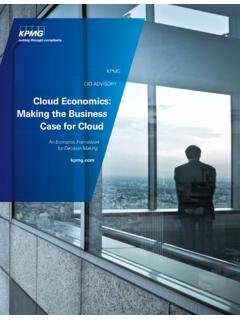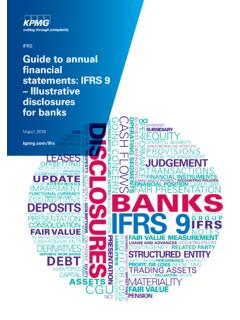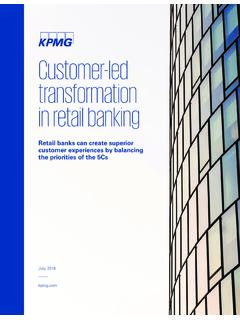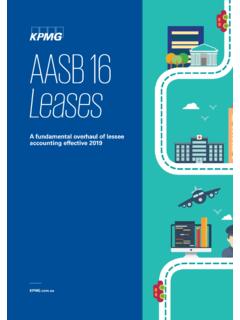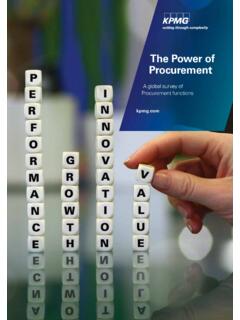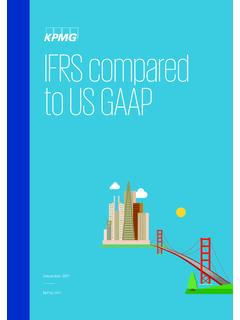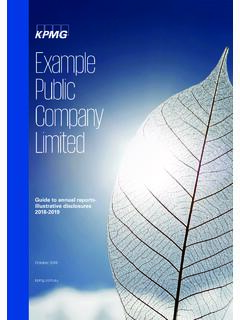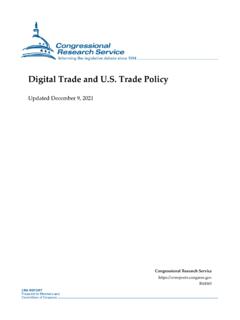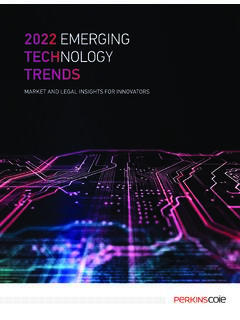Transcription of How to manage five key cloud computing risks
1 How to manage five key cloud computing Gadia is a leader in KPMG LLP s (KPMG) Emerging Technology Risk Services practice focused on cloud Risk Consulting services. He has almost 20 years of experience helping enterprises deliver efficient and effective IT and risk management results. He is the architect of KPMG s cloud Governance and Controls Assessment (CGCA) global framework, which provides KPMG s clients with the tools, resources, and data for cloud computing governance initiatives. Sai also leads KPMG s innovation efforts to research and analyze disruptive technologies such as blockchain. Contact: 2018 KPMG LLP, a Canadian limited liability partnership and a member firm of the KPMG network of independent member firms affiliated with KPMG International Cooperative ( KPMG International ), a Swiss entity. All rights reserved. The KPMG name and logo are registered trademarks or trademarks of KPMG International.
2 How to manage five key cloud computing risksAs the industry matures, there has been a rapid expansion in service offerings. The large cloud service providers (CSPs) that entered the market with SaaS offerings, , , are integrating backwards into PaaS,with s PaaS offering. Likewise, AmazonWeb Services (AWS), which started off largely as an IaaSprovider, now offers not only PaaS but also SaaS a risk perspective, there is some gradient across thedifferent service models, but the deployment model iswhere the risks vary , while cloud computing provides many benefits, at the same time, it introduces major risks on several crucial fronts that need to be governed and managed by user organizations. Well-managed organizations must understand and mitigate these risks to better leverage their cloud computing initiatives. Five major risks security and regulatory2.
3 Technology3. Operational4. Vendor5. computing is the top technology that is disrupting enterprise and consumer markets around the world, thanks to its ubiquity and widespread usage. Within just a relatively short period of time, cloud computing has accelerated in implementation, becoming a key part of IT and business strategy. In the near future, cloud computing will continue to enable the integration of emerging technologies and shape new business models as a strategic Securityand RegulatoryTechnologyOperationalVendorFin ancial1 How to manage five key cloud computing risks 2018 KPMG LLP, a Canadian limited liability partnership and a member firm of the KPMG network of independent member firms affiliated with KPMG International Cooperative ( KPMG International ), a Swiss entity. All rights reserved. The KPMG name and logo are registered trademarks or trademarks of KPMG International.
4 Why companies look up to the cloudOrganizations can realize significant benefits by leveraging cloud computing in their technology and business processes, namely, scalability, flexibility, and lower capital are many small and medium enterprises that have been using the cloud exclusively and have no on-premises servers and related assets. Interestingly, one of the first large companies to shut down its last data center was Netflix in , organizations need to be careful. Much like a failed investment or a poor business decision, not knowing or miscalculating the far-reaching implications of such disruptive technology can leave organizations irrelevant and struggling to keep the last few years, the popular notion was that public cloud is inherently risky, and risk management for cloud computing is primarily the responsibility of CSPs.
5 However, with CSPs increasing their focus on risk management in the last few years, they have thrived. According to a cloud Security Alliance survey, The cloud Balancing Act for IT: Between Promise and Peril, about 65 percent of IT leaders surveyed think that the cloud is as secure or more secure than on-premises fact is also reinforced by industry surveys, including KPMG s 2015 2016 Higher Education Industry Outlook survey, where a majority of higher education administrators are comfortable using the cloud and data protection assurance provided by CSPs. In fact, one of the greatest barriers to adoption has become the lack of clear understanding of the shared-responsibility model under cloud to the same survey from cloud Security Alliance, the top barrier to stopping data loss in the cloud is a lack of skilled security professionals.
6 It is relatively easy for untrained public cloud users to expose their organization to significant direct risks such as financial loss or indirect risks such as loss of is why each organization must understand and mitigate the risks associated with cloud to a September 2015 Gartner report, through 2020, 95 percent of cloud security failures will be the customer s fault. Uber, the world s largest taxi company, owns no vehicles. Facebook, the world s most popular media owner, creates no content. Alibaba, the most valuable retailer, has no inventory. And Airbnb, the world s largest accommodation provider, owns no real estate. Something interesting is happening . Tom Goodwin, senior vice president of strategy and innovation at Havas MediaClouds are secure: Are you using them securely? Gartner, September 22, 2015 2018 KPMG LLP, a Canadian limited liability partnership and a member firm of the KPMG network of independent member firms affiliated with KPMG International Cooperative ( KPMG International ), a Swiss entity.
7 All rights reserved. The KPMG name and logo are registered trademarks or trademarks of KPMG International. Five key cloud computing risksLet us look at five different types of risks and how they apply or vary by cloud deployment security and regulatory riskData security and regulatory risk can be associated with loss, leakage, or unavailability of data. This can cause business interruption, loss of revenue, loss of reputation, or regulatory risk is associated with noncompliance with various national/geographic regulations, industry, or service-specific legal and regulatory requirements such as the Gramm-Leach-Bliley Act (GLBA), Sarbanes-Oxley Act (SOX), Health Insurance Portability and Accountability Act (HIPAA), or the European Union (EU) Data Protection of the most significant new regulatory schemes is the EU General Data Protection Regulation (GDPR) that was recently adopted by the European Parliament, which introduces extensive requirements for any organization doing business in Europe or storing data about EU residents.
8 This requires a new level of tracking data and related consent which requires special considerations when using cloud computing . The consequences for non-compliance are dire, including fines up to 4 percent of global annual turnover/revenues or 20 million, whichever is to the cloud Security Alliance s cloud Adoption in the financial Services sector survey in March 2015, data protection is a preeminent security concern for the financial sector moving to the cloud . In particular, data protection standards and relevant laws were top of mind for survey respondents. Industry regulation drives compliance requiring financial institutions to implement specific security measures to consider migrating to cloud services. At the top of the list were data protection (75 percent), corporate governance (68 percent), PCI-DSS (54 percent), and national regulations (47 percent).
9 According to the cloud Security Alliance survey The cloud Balancing Act for IT: Between Promise and Peril, the primary obstacle to moving systems of record to the cloud noted by percent of companies was the ability to enforce their corporate security policies. Cyber attacks are not the only concern companies have when it comes to moving their systems of record to the cloud percent of companies see compliance with regulations as a major barrier to cloud a private cloud , the data risks do not change as much compared to traditional computing , as organizations have better control and understanding on how various government rules, laws, and regulations apply to them. Further, there is no comingling of data across multiple cloud users. However, additional risks apply to private external cloud : Lack of visibility into controls over initiation, authorization, recording, processing, or reporting of transactions Unauthorized data access by a service provider and/or less control over who sees what data , the service provider might be using contractors or third a public cloud , the data risks associated with the private external cloud apply.
10 Additionally, the following risks apply: Data leakage or access risks due to multitenancy/shared infrastructure between different organizations Lack of flexibility over data protections mechanisms, such as encryption and implementation of specific controls by data type. Different organizations might have different encryption and control requirements, and a public cloud provider may not be able to customize their infrastructure or provide customers the control over encryption keys. This is particularly relevant in case of solutions delivered under SaaS and PaaS view on how to manage this risk: In KPMG s experience, leading organizations have mature data protection and regulatory compliance programs staffed with talented individuals who have sufficient authority and clear responsibilities. Such organizations also leverage leading third-party or homegrown automated tools and continuously improve their to manage five key cloud computing risks 2018 KPMG LLP, a Canadian limited liability partnership and a member firm of the KPMG network of independent member firms affiliated with KPMG International Cooperative ( KPMG International ), a Swiss entity.
